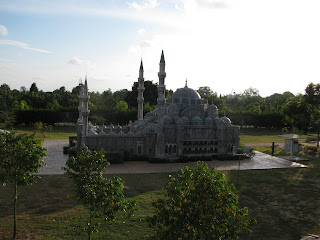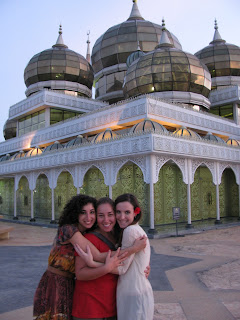I began my journey across the pacific, from Beantown to LA then to Hong Kong. After 30+ hours in transit, I arrived at my final destination- Kuala Lumpur, Malaysia.
I spent 8 days in KL in my Fulbright orientation. We come from all over the states, from Cali, to Wisconsin, to Virginia, and everywhere in between. The Malaysian-American Commission on Educational Exchange (MACEE) held workshops, some planned outings (including a day trip to Melaka), and a ton of bonding activities. We even went out to a small village to meet a famous traditional Malay dancer and learn about traditional Malaysian culture, including ceremonial dress, folklore, musical instruments, food, etc. She built a complex for her dancer troop amongst a giant garden of flowers and trees indigenous to Malaysia. There are 16 other ETAs in the U.S. Fulbright Program. We range in ages from 21-26- all have their Bachelors, and a couple have their Masters degrees. We also had a day of orientation at the U.S. Embassy and went to a party at the U.S. Ambassador's house.
KL is a very modern city- so most people come here for to shop or to see the famous Petronas twin towers. It’s not really a place for art or culture attractions, like many European cities. But, the food is where it’s at- especially the roadside food stalls. The dingy decor, fluorescent lighting, plastic chairs, and less than hygienic standards are definitely turn offs at most eateries- but that usually means the food is good and authentic. They spend their money on the food, not the atmosphere. KL is a fabulous mix of Malay Muslims, southern Tamil-speaking Indians (usually Hindu), and Chinese (usually from southern China). All this equals good food.
My most favorite things to do in KL:
-Walk around Chinatown (centered around Jalan Petaling) and pick up some freshly made soy milk topped with brown sugar syrup, while you browse the seriously cheap knock off digs.
-Go to the Central Market have a 'fish' pedicure. You will sit on benches and for 5RM (less than 2 bucks) have your feet tickled to death for 10 minutes by fish that eat the dead skin off of your feet.
- An absolute must if venturing to KL: Get out of KL. Go about a 15 minute drive outside the city, by taxi, to the Batu Caves. A towering limestone mound juts out of the earth and holds within it impressive caves, which have since their discovery become home to a Hindu shrine. An enormous golden statue of Muruga, aka Lord Subramaniam, to whom the caves are dedicated, stands at the foot of a flight of 272 steep steps leading up to the Temple Cave. Monkeys mingle amongst the crowds of Hindu Indians making their pilgrimage to the top. The people- from the elderly to the infant, with their bright colored sarees and flower offerings draped around their necks, are almost as beautiful as the various statues and enclaves sprinkled throughout the cave complex.
Kuala Lumpur's Famous Petronas Towers
The grand entrance to the Batu Caves
Monkeys mingle amongst Hindu idols
Bright colored girls
The Temple Cave
A perfect spot in the cave to catch up on the news
A Famosa Portuguese Fortress in Melaka
Traditional Malaysian musical instruments and puppets
Muslim Surfers
I shall begin with a necessary but deviating aside: Once you get outside of KL you will find that Malaysians do not use toilet paper. They use a hose sort of like a bidet. Basically, the bathroom floors are soaking wet at all times. I have no idea how it works, so I try to bring tissues with me everywhere I go. Malaysian toilets (often found in the 20 sen a pop public toilets, tandas awam) are squatty potties- aka a hole in the ground which you must squat over, feet on either side. I am still baffled by it all- like, “how are they not soaking wet if they use a hose and no paper?” among many other questions I have, but am too fearful to ask anyone who would know the answer to them.
After KL we all went to Kuala Terengganu (KT), the capital of my state of Terengganu to continue orientation led by state government officials from Terengganu. The state of Terengganu lies on the northeastern coast of Malaysia, opposite KL, which lies in the southwest.
Unlike KL, with its cosmopolitan, diverse climate, Terengganu is almost 100% ethnic Malays, all of whom are Muslim. Terengganu is one of the most conservatively Islamic states in the country. The weekend falls on Friday and Saturday, because Friday is the holy day in Islam. But Terengganu is also known for its beaches and islands, and with it, an accompanying laid-back vibe. We spent 2 weeks at a KT hotel right on the beach. But in a town where bikinis are taboo, and the monsoon season (which runs roughly from November to March) made the waves too big to swim in, beach-going was definitely a different experience than in the states. However, we befriended some Malaysian surfer guys who hit the KT beach daily during monsoon season. We also befriended some local boys, about age 12, who we played soccer with on the beach. We all had a huge bonfire one night on the beach. The surfers brought the wood, which seemed like they just had ripped off of a nearby palm tree. They also brought a contraption: a long rope with a bundle of steel wool at the end. They dipped the end in the fire and swung the rope around creating a spectacular display of flying sparks. It was amazing: 17 American ETAs, Malaysian surfer dudes, and a collection of über-curious, non-English speaking Malay boys- all sitting around a moonlit fire, listening to the waves as we watched our handmade fireworks display.
Things to see/do in Kuala Terengganu:
-The Crystal Mosque, constructed from glass and steel, lies on the riverfront. Catch a glimpse of it at night, when the entire thing is lit from within. Next door to the crystal mosque is the Taman Tamandu Islam- or Islamic Civilization Park- a series of miniature models of famous Islamic landmarks and mosques from around the globe. In one loop you will see the Taj Mahal, next to Mecca, etc. It is totally doable in an hour or so, but it just might be the closest you’ll ever come to seeing the life-size versions up-close.
-The beautiful white ‘Floating Mosque,’ built on a man-made island is also a wonderful sight to behold.
- The Terengganu State Museum is the largest museum in Southeast Asia and includes a village of traditional houses as well as a full blown museum complex housing traditional Malay artifacts.
-Check out the Pasar Payang or central market. Downstairs you will find an enormous food market, which holds barley-dead-yet fish, and just about every Malaysian ingredient you don’t know the name of or don’t know what to do with. Upstairs is a vast collection of stalls selling rather affordable batik (produced by drawing or printing a pattern on fabric with wax and then dyeing the material) and songket (cloth brocaded with gold and silver threads). Batik and songket are specialty crafts of Terengganu. Batik is worn by all Malays, sometimes on a daily basis, but songket is usually reserved for very formal occasions, as it is traditionally, the fabric for the royal family.***
***Oh yes, I probably should explain Malaysia’s government. Malaysia has 13 states. 9 out of 13 states have hereditary rulers (sultans), while the other 4 have appointed governors. Every 5 years a sultan takes his turn in the ceremonial position of king. Since 2006, the king of Malaysia has been the sultan of Terengganu. The king is the head of state and the leader of the Islamic faith. However, the country is led, in actuality, by the prime minister and parliamentary government (similar to Britain).
Kemaman
At the end of our orientation in KT, we had a 'handing over' ceremony, in which we were 'handed over' to our new schools. It was somewhat heart-wrenching to be pried away from this new family of ETAs we had gotten so close to during the previous three weeks. But it was time to begin what we were all sent here to do- teach English!...
The state of Terengganu has 7 districts. From north to south they are: Besut, Setiu, Kuala Terengganu, Hulu Terengganu, Marang, Dungun, and Kemaman. 6 ETAs are living together in an apartment in KT; the other 11 are spread all over the state. Some have roommates, some do not. I live in the district of Kemaman, in the town of Cukai (also spelled Chukai) the southernmost town in all of Terengganu- on the border of the nearby state of Pahang. Imagine that most people are in Boston, Eastern Mass, and Central Mass- but I'm way out in the Berkshires. Luckily there is another ETA about a 20 min drive away in the nearby town of Kijal. And…I was given a motorbike by my school!!! I am a little terrified because a) they drive on the left side of the road here (thanks to good ole British imperialism) b) the bike is a standard and c) I've never even come close to driving a motorcycle. But I have a helmet and I’m ready to go!
'Fireworks' at our KT campfire
A portrait at the state museum, which looks exactly like one of my Malay surfer friends
Terengganu State Museum
Traditional Malay house at the state museum
At the state museum
Look- the Taj Mahal in KT!
Replica of the Dome of the Rock mosque in Jerusalem
The Blue Mosque of Istanbul
Look- the Taj Mahal in KT!
Replica of the Dome of the Rock mosque in Jerusalem
The Blue Mosque of Istanbul
Spain's Alambra- one of the many miniature mosques at the Islamic Civilization Park
KT's pride: the Crystal Mosque
At the Crystal Mosque with Olivia and Rebecca
One of my Malaysian surfer friends riding the waves!






















No comments:
Post a Comment